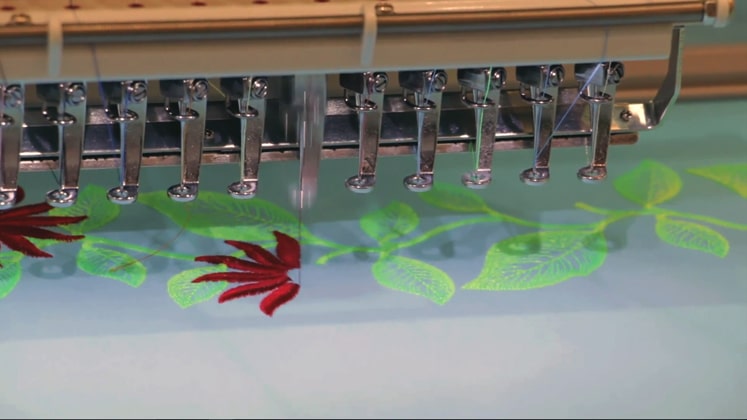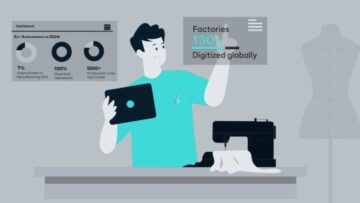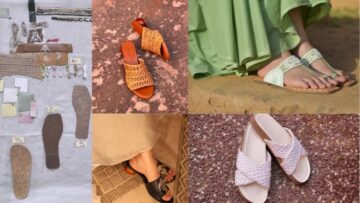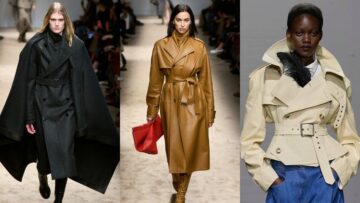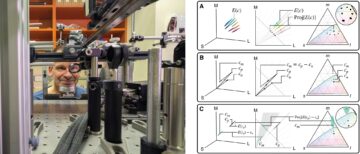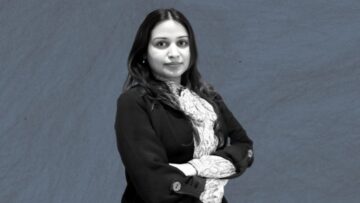The increasing demand for value added garments can be seen through the designs ruling the fashion shows and catwalks, and predicted to continue increasing in the future too. Driven by innovations in garment decoration technology, brands use a wide range of creative and ingenious decorative techniques like embroidery, screen printing, digital printing, laser engraving, sublimation and embellishing with sequins, rhinestones and decorative tapes attachment to add value to their fabrics and garments. Team Apparel Online recently participated in GTE, Delhi and KnitTech, Tirupur to bring latest advancements in garment decoration…
Flexibility being the demand of the moment, machine manufacturers have added multiple devices to allow the embroidery machine to attach sequin, coiling, cording, opening up a world of newer and creative possibilities, as the machine can also be customized according to the need of the user by increasing the width of the table to accommodate larger fabric or even increase the number of embroidery heads. Today, machines can be bought with double sequin, 4-sequin, even 6-sequin devices attached to each head that can attach sequins from 2 mm to 19 mm in diameter, in any conceivable shape and colour. One can mix sizes, colours, shapes, even apply 2 sequins, one on top of another, in a single stroke, thus creating a sandwich.
Coiling, a technique which uses a tape or ribbon to create patterns on a fabric is widely used in home furnishing such as bed spreads, pillow covers and curtains.
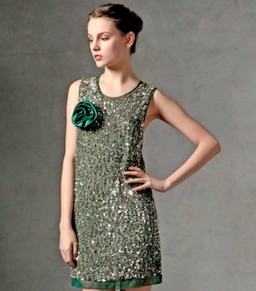
Creativity has no boundaries; another interesting development is threadless embroidery. It is the process of forming a design in a mirror-like fashion by applying a threadless embroidery needle to the reverse side of the fabric and moving the needle up and down continuously following the design pattern. This breaks the surface of the fabric structure thus creating a fuzz texture forming the design on the surface of the fabric.
Other advancements include auto bobbin changer, which can replace under bobbin threads for all of the heads in one go; built-in automatic needle threader, which avoids the hassle of re-threading whenever there is a thread breakage in the machine and perfect synchronization of X-Y axis in a machine, which earlier used to cause design shifting during the embroidery process. All the other features enhance the productivity of the machine immensely.
From single to multi heads and non-computerized to computerized machines, various brands offer different models, suiting the need of the consumer. A feature of “Selective Head” mechanism is also present in some models, in which one can choose various numbers of heads to be combined in different configurations to sew specific embroidery designs.
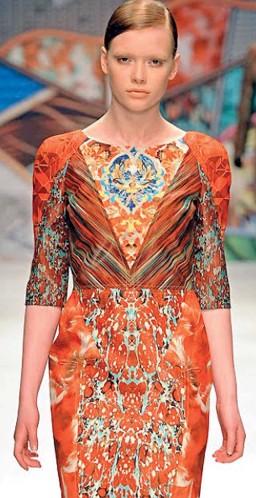
While embroidery is popular for decades it is direct to garment digital printing and sublimation technique which are quite popular now. With the entry of first level direct to garment printers in market; screen printing as a trend had started losing its edge. But to support screen printing, machine manufacturers have come up with many innovative techniques and technologies to the market.
Available from manual to semi-automatic to fully automatic screen printing machines, various models offer many advantages. The fully automatic screen printers have features such as servo-driven indexers, multiple print-stroke capability and availability of multiple colour models which offers the capability to print in multiple colours; even 45-50 colours in some models. The servo-driven indexer is an advanced processor that helps in executing the command precisely. Through its multiple print-stroke capability, the printer can fill a single colour in multiple strokes and can go up to 9 strokes per colour to achieve fine printing.
Machines are available having new colour touch-screen interface with graphical displays and icon-based labelling that can show information and commands in numerous languages, simplifying press operation and training anywhere in the world. Also included are onboard self-diagnostics and real-time production data display.The productivity in such machines is much higher as the average production from a conventional screen printing system would be around 400-500 pieces per hour while in the new system it is about 1200 pieces per hour from the same work station, which can increase if more stations are added.
Since the energy costs are rising day-by-day, manufacturers have developed state-of-the-art screen printing machine which works without a compressor, hence saving on a lot of power consumption.
The quality of frames used in a screen printer is defined by following parameters such as mesh count, deciding the resolution of edges in the design and the appropriate tension of the frame. Other properties such as ink release, registration of colours, printing speed in relation to the ink viscosity and ink flow and consumption during printing determines the quality of screen printing.
Curing is required as a post-treatment in screen printing which helps in drying and increasing the life of the print. Many machine manufacturers have integrated the curer in the screen printing equipment itself, eliminating the need of buying a separate curing machine.
A shift is observed from analogue to digital printing – starting with roll to roll printers that imaged directly onto fabric that would later be cut and sewn.
Today, there are at least ten or more viable direct to garment printer manufacturers in the market, with virtually all of them offering the ability to image on both light and dark garments. It is now possible to offer full colour, short run digital graphics to customers quickly and without the traditional setup costs and large minimum requirements.
Technology such as sophisticated printing blanket with glue (“sticky belt”) holds the fabric in place while printing. This technology allows for printing on 4-way stretch material that is not possible in previous models of digital printers. Since garments, especially cotton apparels are absorbent in nature, it is important that the white ink stays on top of the fabric in order to create a base for the other colours to sit on top of it. This is achieved by a process called pre-treatment. Nowadays, the pre-treatment process is integrated into the printer itself, hence saving a lot of time and cost. With the early developed printing machines, feel of the garment was always a concern. Now with the printers that print with the minutest ink drop size and adequate pre-treatment, one can easily obtain garments with softer feel.
The acceptability of digital printing among the designers and even brands has motivated many developments which includes increasing the machine speed to 1000m2/hour; printers are also available which has an integrated degassing system that enables an uninterrupted ink flow and improved print quality due to an increased DPI (dots per inch) of 1440. Advanced print heads can print up to a maximum of 8 drop sizes which allows even a greater control of the printed image resulting in smoother colour gradients and more precisely matched tones.
Today, there are at least ten or more viable direct to garment printer manufacturers in the market, with virtually all of them offering the ability to image on both light and dark garments. It is now possible to offer full colour, short run digital graphics to customers quickly and without the traditional setup costs and large minimum requirements.
Sublimation printing is another way of decorating apparels in a cost-friendly manner obtaining instant results. A lot of bleeding occurs in prints done with inkjet printers making it necessary to wash the garment before wearing, but in sublimation printers there is no such requirement as it uses a gaseous process to transfer ink to the fabric and no separate layer of adhesive is transferred to the substrate. It also has a soft feel and it will never fade or crack on the garments. The printers are equipped with vacuum feature which allows a deep penetration of the ink, eliminating the discolouration of the substrate due to rubbing action.
The laser technology is being applied for decorative purposes and to produce unusual looks in fashion design. It can engrave simple or complex patterns and designs through laser beam scanning on the surface of fabric or directly on the garment. It also has a major application in precise cutting of a design as an appliqué work. Laser engraving can also be used for the de-colouration of indigo-dye on fabrics. Depending on the end result, customers can choose from a wide variety of laser engraving models such as industrial laser engraving system, pneumatic laser engraving system and portable laser engraving machines.
Nowadays, laser engravers are equipped with operator safety alarms; top exhaust suction system; linear guide to achieve precision under high speed; enhanced structure of front and rear doors to accommodate large work pieces; and an automatic feeding and rewinding system. One of the recent advancements is the technique of ‘flying engraving’, in which engraving is possible while the material is moving.
To add individuality to the designs, machine manufacturers have also developed bridge with a laser head, with which an existing embroidery machine can be upgraded to a bridge embroidery laser engraving cutting machine. Advanced lens and dynamic focusing system ensures the laser beam with precise cutting, within large size area, compared with traditional belt guide and laser heads.
Different types of laser treatments can be achieved by using different machines such as carbon dioxide laser (CO2 laser), neodymium-doped yttrium aluminium garnet laser (Nd: YAG) and diodes lasers. CO2 laser is the most efficient and suitable for engraving textiles. To improve the visual appearance, different design methods such as the graphic design method and the resist design method were applied for the CO2 laser engraving onto garments made from rayon/polyester blended fabric with ideal laser engraving parameters including the resolution (dpi) and the pixel time (μs).
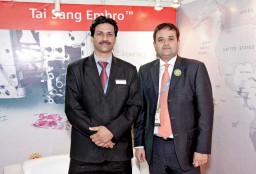
Latest Options in Embroidery
India has been known for its embroidery techniques for ages and with new technology also coming in, the art of embroidery has got a new dimension for manufacturers looking to enhance value…
Tai Sang customizes embroidery solutions
Fashion quotients are changing very fast, which has made Tai Sang’s machines a hit in the market, for their ability to customize the machine for unique embroidery needs. The machines can do embroidery even on a fabric as light as 15 GSM going up to 300 GSM. With its three series of embroidery machines, namely Vista, Excellence and Platinum, Tai Sang offers embroidery machines with, sewing speed varying between 850 RPM to 1200 RPM and embroidery heads ranging from 1 to 44.
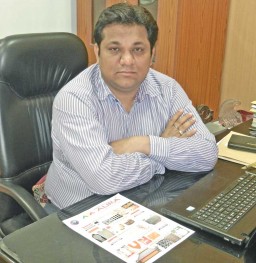
Except the Vista series, the other two series – excellence and platinum – can be easily modified for other value added purposes by affixing various attachments such as single or double sequin device, Chenille, taping, cording device and a mix of all of them. Each embroidery machine is equipped with noise reduction element which helps in creating a quieter working condition for the operators. The embroidery machines can also reach to the maximum working width of 2.4 metres in order to perform embroidery on large pieces of garments.
Aura Technologies offers cording, coiling and taping mix type embroidery machine and bead cord making machine
Aura Technologies always strives to bring best technology at affordable prices with complete end-to-end solutions including designing concepts, raw materials sourcing, etc. The company has brought to the industry, its flat embroidery machine, claimed to be the world’s fastest coiling machine, which turns and twists the tape into 360 degree to make a rope effect at a maximum of 900 practical working speed on all types of fabric.
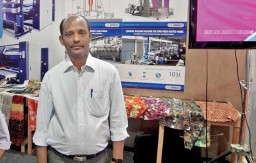
Another innovation is the bead cord making machine. The machine can form a cord or string of beads automatically by just feeding the loose beads into the machine. The company has also launched a double sequin device machine which can attach a sequin of the smallest size of 2 mm to the largest jumbo size of 22 mm, providing the facility of attaching all types of sequin using one machine only. Apart from these value addition attachments, Aura embroidery machines can embroider a yarn of 1200 denier with ease.
Unity Overseas promotes Tajima TFGN series
Unity Overseas Tirupur, the distributor for Tamil Nadu and Kerala of a popular Japanese brand Tajima embroidery machine, displayed two types of models of TFGN series, one which can handle standard embroidery type and the other for jumbo design embroidery. In both the models, number of heads varies from 12 to 30 and can store up to 99 designs in its memory. A design which can be automatically repeated up to 99 times, front to back or side to side, respectively.
Technology innovators have an array of latest, quality-driven, cost-effective and highly productive embroidery, printing and laser engraving solutions for the industry…
Keeping the fast changing fashion in mind, customer can select from a wide variety of value adding devices such as high speed sequin device which can attach various shapes and sizes of sequins from 2 mm to 9 mm diameters, stitched at a high speed of 1000 RPM with the possibility of producing 4 colour sequin as well. To minimize the work of changing under thread bobbins, an automatic bobbin changer can be added to the machine which can replace under bobbin threads for all of the heads at once. Another series which is gaining attention in the industry is the TLMX series. The special lockstitch embroidery machine comes with multi function like cording, taping, coiling, blind embroidery, frill embroidery; tuck embroidery, standing embroidery, and slub cord embroidery with full lineup of combinations with sequin and chenille embroidery. These specialized machines are already installed in various countries where they are doing high value garments.
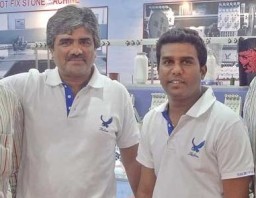
Golden Falcon launches its latest hot-fixing embroidery machine
Flat embroidery machines, sequin machines, cording and taping machines, chenille machines and retro fittings of sequin device are key technologies that have replaced handwork and are in demand. Golden Falcon has to offer embroidery machine which can perform embroidery, cording, sequencing and stone fixing without adding any supporting attachment in the machine. A compact machine, it is ideal for the garment manufacturers who face the demands of today’s changing fashion.
Printing Technology in Demand
Printing technology has come a long way and garment manufacturers are using the latest technology to add value to their collections, whether it is screen printing, sublimation printing, digital printing or a combination of various techniques…
DCC offers M&R Sportsman EX screen printing machine and digital printer by Epson
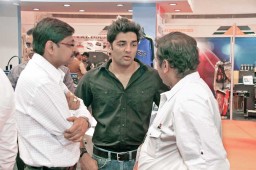
Known in the textile industry as solution providers for the printing industry, DCC is very confident of the capabilities of the M&R screen printers that it presents in India. The unique oval shape of Sportsman EX from M&R, gives flexibility to add and subtract work stations and print heads as per capacity requirement up to 62 stations.
It also has the ability to work with up to 58 colours and different applications like flock, foil, glitter, which previously was possible only with digital printing. Also, since each print head is independent, as many as desired prints can be done simultaneously.
Offered in two versions, the Sportsman EX 1618 is available in 8 and 10-colour models with a maximum image area of 41 x 46 cm (16” x 18”), while the Sportsman EX 2020 is available in 8, 10, and 12-colour models with a maximum image area of 51 x 51 cm (20” x 20”). Electric print heads are standard on Sportsman EX 2020 models and optional on Sportsman EX 1618 models.
Machines are available having new colour touch-screen interface with graphical displays and icon-based labelling that can show information and commands in numerous languages
The company also has on offer latest digital printer Epson PRO 4900, with a high performance print head and 360 nozzles per channel that handles ten separate ink channels to deliver professional quality prints every time.
A minimum of 3.5 pl (pico litres) ink droplet size can be obtained, adding to the print quality. Epson uses a room temperature mechanical piezo technology of precise electrical pulses that causes the ink reservoir wall in the head to compress, projecting ink through the nozzle. Programmers can also control the exact placement, size and shape of each ‘dot’ to shape with the millions of ink droplets they eject in each square inch.
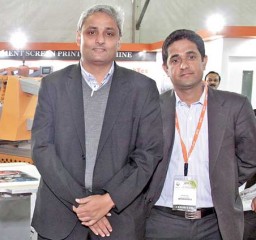
Industry friendly, Grafica – Nano-prinTex
Nano-prinTex from Grafica, a pioneer in manufacturing screen printing machines works smoothly without a compressor, hence saving on power. Grafica claims that Nano-prinTex is the world’s first all-electrical mechanical line of automatic textile printers. The touch screen panel in the Nano-prinTex is kept simple to let the operator follow easy steps with clear legible icons for easier non language comprehension, so that nothing is overlooked or compromized. The machine has a higher image to frame ratio which considerably enhances the print quality for more exact reproduction.
The high quality pressure-die cast aluminum squeegee head provides exceptional rigidity and strength for constant dependability. Micro registration system is available for screen frame movement with reference mark and locking device. Fully hardened WPS steel cams are used for index movement to maintain consistent repetition accuracy and to achieve perfect registration, thereby reducing wear and tear.
Kornit Digital offers Kornit Breeze Direct to Garment Printer and Kornit Paradigm Digital Add-on Solution
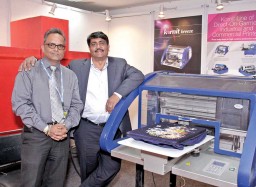
Known for affordable and high quality printing on both dark and light garments, the Kornit Breeze printer is designed to allow garment decorators to enjoy high-end technology benefits at minimum cost. Besides, Kornit also continues its partnership with Spectra by featuring again its unique ink system that includes six industrial print heads (CMYK and white) with 256 nozzles included in each. The Kornit Breeze is easy to operate and maintain. The printer can be connected to any computer using a USB port. Without the need for an air compressor, it can basically be operated from almost any site – office, shop or factory. The printer uses Kornit’s proprietary pigmented ink and the Kornit QuickP file preparation and ripping software.
Another interesting offering from the company is the Kornit Paradigm, a digital add-on solution for screen printing carousels, designed to enable screen printers to combine printing techniques and create multiple innovative printing applications by using traditional screen printing methods together with Kornit’s digital direct on garment printing, all-in-one built-in printing module. This industrial direct on garment printer, attached to the carousel carries a digital station that is compatible with screen printing carousels. The add-on station uses four Spectra Polaris print heads that are available with both CMYK and white inks. The Kornit Paradigm printer is capable of producing a variety of applications including dark garment applications, variable data combinations, complicated four colour processes and spot combinations and pure digital applications for short-runs.
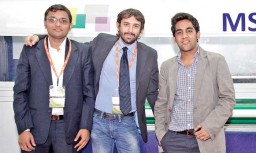
MS Orange introduces entry level printers eyeing domestic customers
With a strong hold in Mumbai, Surat, and Ahmedabad, MS Orange is now eyeing Northern regions, concentrating on Ludhiana, Panipat and Delhi in particular. The company is seeing good response to its entry level industrial high speed digital printing machine called MS JP5 evo, which is one of the fastest printing solutions in the market and can work up to a speed of 100 lin. met/h, printing at 180 cm width. This 8-colour machine with four Kyocera two-colour print heads is an ideal replacement for many expansive brand machines available in the market. Even at its peak speed, the machine can execute high resolution printing. The machine uses an open ink feeding system and has an embedded web server for cost report. Open ink feeding system indicates that inks from all main manufacturers available in the market, having compatible characteristics can be used. The Diva roller fabric handling system allows for the widest variety of fabric but as speed increases a more sophisticated fabric handling system is required. MS has used their extensive knowledge in screen printing and incorporated it into the digital printer technology, to develop best possible digital printer solutions.
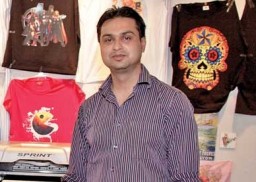
Latest AnaJet SPRINT and mPower Digital Printers from P.A.S
AnaJet is leading the way with new and improved direct to garment digital printers, the SPRINT and mPower, which is available in India through their distributor, P.A.S. Both models are equipped with a robust industrial print head and a new, innovative, patented ink delivery and recirculation system. This easy-to-use system requires much less maintenance, and due to its compact size, does not require much space and labour to operate.
It takes only a single minute, to print a 10” x 10” graphic with AnaJet SPRINT. Apparel printing demands more ink flow than any other inkjet application and to achieve the same, a closed loop ink delivery system with sealed ink cartridges is essential. The system helps in maintaining the integrity of the ink and pressure balance to prevent ink nozzle clogging. The printer can print directly onto T-shirts, scarves, shirts, aprons, canvas bags, towels, mouse pads and pillow cases.
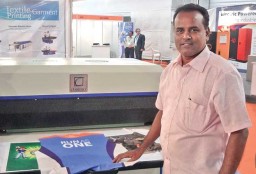
Cheran launches innovative sublimation heat transfer printer
Since polyester based garments are currently in trend, Cheran Machines has launched its sublimation transfer print machine with an in-built vacuum system, which is among the first of its type in India and suitable for printing on polyester, especially sportswear. The vacuum feature allows a deep penetration of the ink, eliminating the discolouration of the substrate due to rubbing action, and also appearance of white fibres on the surface when stretching Lycra fabrics.
Nassenger Pro 60 available with Apsom Technologies
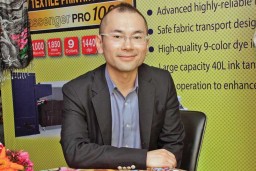
The Nassenger Pro 60, digital printer by Konica Minolta, which can be used on varied fabric ranging from cotton to nylon to silk, is one of the hottest selling products with Apsom Technologies. With nine 512 nozzle high density print heads, this machine has a specialty feature of printing compact designs on the widest fabric, with maximum width of the machine being 72” or 1.8 m. The two most important aspects of a printer are the print head and the ink, in order to have a constant output from the machine; and both are indigenously manufactured. With a tank capacity of 6 litres having a consumption rate up to 1000 metres/litre, Nassenger Pro 60 is compatible with high to low speed production which ranges from 9m2 – 60 m2/hour and can also perform short to high volume of printing without compromising the quality. Apsom also has in its portfolio the latest and innovative dye sublimation transfer textile printer – Fabrijet FTII-1804 by DGI. The printer has a detachable drying unit and is equipped with a Konica Minolta print head with advanced print head cleaning system.
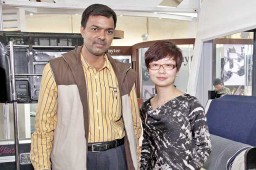
Laser Technology, a Growing Trend
Value adding may be an art, but with latest technology the variety of options available for creative input is immense. One technology that is increasingly being used is laser and engraving technology…
Latest Saturn engraving series by Golden Laser
Manufacturer and provider of laser machines for various applications for textiles, garments, metal, wood, plastic and acrylic industries, Golden Laser’s latest series of roll to roll engraving and punching Saturn engraving technology is especially designed for continuous engraving and punching process. The width of the working table can reach up to 1600 mm. The machine is equipped with red light positioning device which ensures multiple data transmission mode and can run in offline and online modes. The engraver is suitable for large format engraving and works on flying engraving technique.
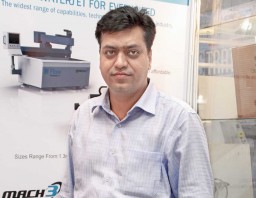
Angel India offers CMA-6040K and Laser Pro Spirit for Laser engraving
Engaged in the sphere of importing, supplying and trading a wide assortment of imaging and printing products, the latest technology with Angel India is the newly launched laser engravers – CMA-6040K and Laser Pro Spirit. CMA-6040K engraves at a speed of 0-64000 mm/min at a temperature of 0-45 degree celsius. The equipment is suitable for non-metallic materials. Laser Pro Spirit has a working area of 25” x 18” with a high working speed of 60 IPS (inch per second). To ensure operator safety during the process, a smart guard fire alarm device is provided.

